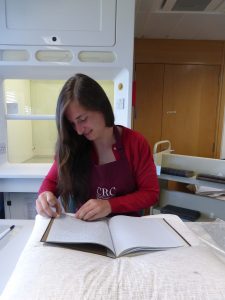Joey Shuker, conservation placement student from Camberwell College of Art describes her experience of working at the CRC in this week’s blog post…
I have been very fortunate to have spent the last four weeks in the CRC as part of my summer placement for my masters degree in Conservation of Paper. I have just finished the first year of a two-year masters at Camberwell College of Art, part of the University of Arts London.
I have been working mostly in the studio with Emily Hick, but my placement here has also taken me to the National Library of Scotland conservation studios, The Scottish Conservation Studio (private studio) and I have spent days working at the Annexe (the CRC’s of site facility) with Katharine Richardson.
One of the projects I spent most time working on was conserving a collection of photographs of Leith in the 1920s.The condition in which the photographs arrived in meant they where not able to be digitised. The prints were mounted on thick card that had distorted due to past environmental and storage conditions. The distortion of the card mount was pulling and creasing the photograph. Being so distorted meant that any pressure to put them under glass during the digitisation process would have caused more damage to the print. The decision was made (before I arrived) to remove the mount backing which would allow the prints to relax and flatten.
Days were spent removing the backing down to the layer just above the back of the print. A scalpel with a no.22 blade was used to remove the backing layer by layer and a pencil grid was drawn on each layer to ensure even removal which would support the print during this process.
 Curved photograph and mount |
|

Grid on back to aid even removal of card
After the majority of the backing mount had been removed and the prints began to relax and could be pressed under glass overnight. Backing removal was something I had learnt on my course but I had only ever done it on large prints rather than a collection of small ones.
Doing aqueous treatments on photographs was something I had not yet covered on my course. Emily showed me a humidification method that allowed enough moisture to soften the paste holding the last backing layer on, but didn’t affect the print. We used fords gold medal blotter, which was recommended for use with photographs as it is thinner and holds less water. We used a blotter sandwich for humidification, the print were humidified for 30 minutes. After this time, the last layer of backing could be easily peeled away and the paste could be removed with a spatula.
 Blotter sandwich for humidification |
|

Removing the paste
After this treatment and being put into a press for a couple of days, the box of photographs that arrived at CRC curved and stiff are now relaxed and flattened and ready to be sent to the photography lab for digitisation. This was a great project to work on as I could follow the project almost from start to finish.
I have learnt many new skills and I have been introduced to new treatment methods throughout my time here. Alongside working with Emily and the conservation team in the studio, I have also had introductions to other members of staff who have taken time to show me their role in the wider CRC such as the Archives, Photography Lab, Exhibitions, Rare Books and the Musical Instruments Conservation studio.
This placement has been highly valuable to my studies and preparing for work after university. Many thanks to everyone at the CRC that I have met during my time here.
Joey Shuker
Conservation Student Placement

